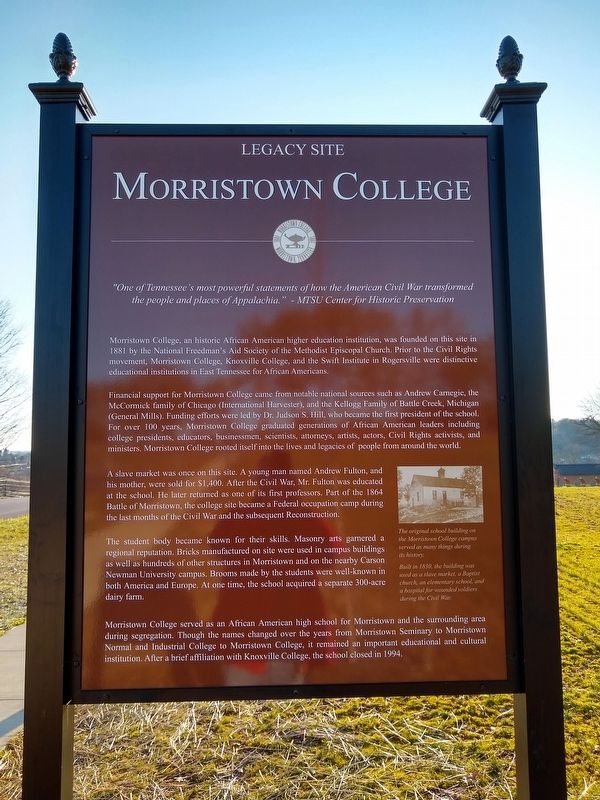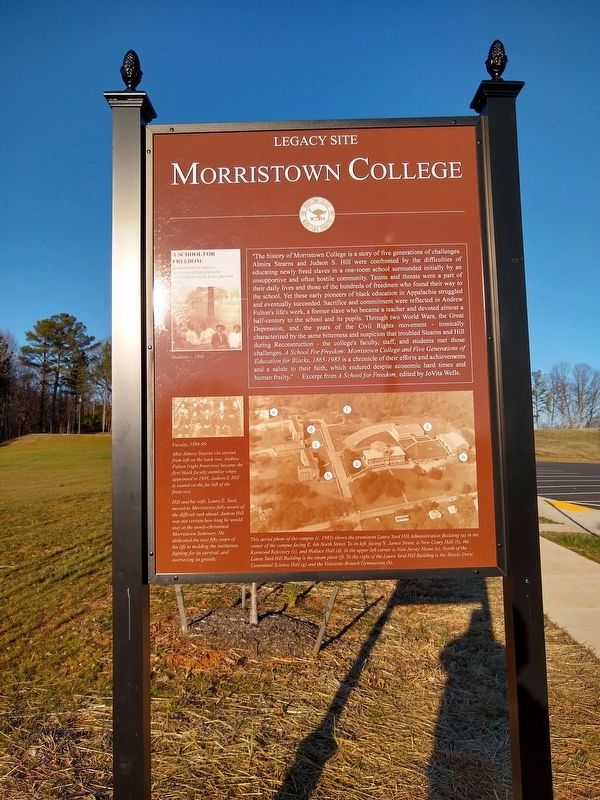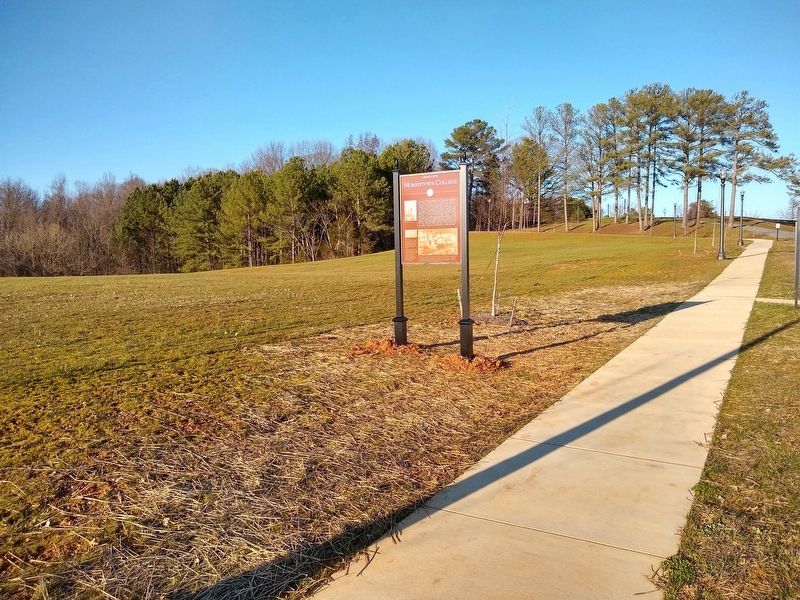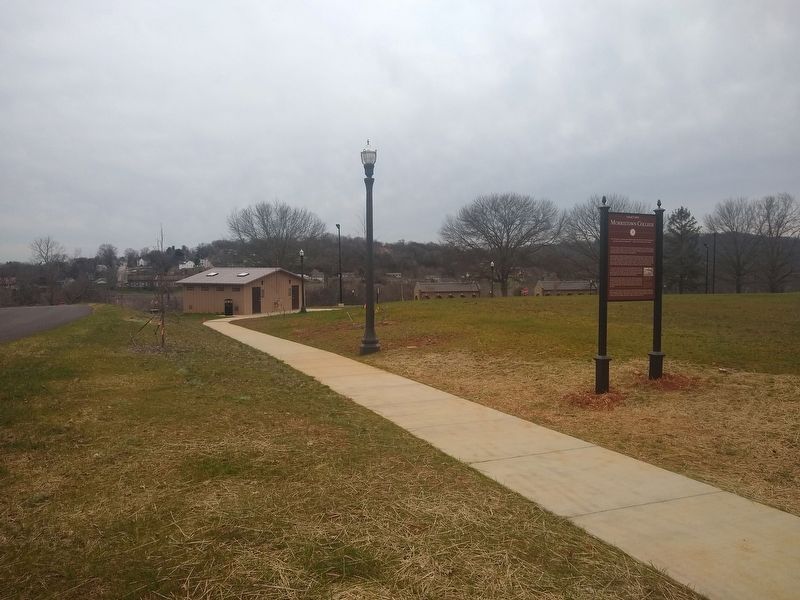Morristown in Hamblen County, Tennessee — The American South (East South Central)
Morristown College
Legacy Site
Morristown College, an historic African American higher education institution, was founded on this site in 1881 by the National Freedman’s Aid Society of the Methodist Episcopal Church. Prior to the Civil Rights movement, Morristown College, Knoxville College, and the Swift Institute in Rogersville were distinctive educational institutions in East Tennessee for African Americans.
Financial support for Morristown College came from notable national sources such as Andrew Carnegie, the McCormick family of Chicago (International Harvester), and the Kellogg Family of Battle Creek, Michigan (General Mills). Funding efforts were led by Dr. Judson S. Hill, who became the first president of the school. For over 100 years, Morristown College graduated generations of African America leaders including college presidents, educators, businessmen, scientist, attorneys, artists, actors, Civil Rights activists, and ministers. Morristown College rooted itself into the lives and legacies of people from around the world.
A slave market was once on this site. A young man named Andrew Fulton, and his mother, were sold for $1,400. After the Civil War, Mr. Fulton was educated at the school. He later returned as one of its first professors. Part of the 1864 Battle of Morristown, the college site became a Federal occupation camp during the last months of the Civil War and the subsequent Reconstruction.
The student body became known for their skills. Masonry arts garnered a regional reputation. Bricks manufactured on site were used in campus buildings as well as hundreds of other structures in Morristown and on the nearby Carson Newman University campus. Brooms made by the students were well-known in both American and Europe. At one time, the school acquired a separate 300-acre dairy farm.
Morristown College served as an African American high school for Morristown and the surrounding area during segregation. Though the names changed over the years from Morristown Seminary to Morristown Normal and Industrial College to Morristown College, it remained an important educational and cultural institution. After a brief affiliation with Knoxville College, the school closed in 1994.
[Caption:]
The original school building on the Morristown College campus served as many things during its history. Built in 1830, the building was used as a slave market, a Baptist Church, and elementary school, and a hospital for wounded soldiers during the Civil War.
[Reverse:]
“The history of Morristown College is a story of five generations of challenges. Almira Stearns and Judson S. Hill were confronted by the difficulties of educating newly freed slaves in a one-room school surrounded initially by an unsupportive and often hostile community. Taunts and threats were a part of their daily lives and those of the hundreds of freedmen who found their way to the school. Yet these early pioneers of black education in Appalachia struggled and eventually succeeded. Sacrifice and commitment were reflected in Andrew Fulton’s life’s work, a former slave who became a teacher and devoted almost a half-century to the school and its pupils. Through two World Wars, the Great Depression, and the years of the Civil Rights movement – ironically characterized by the same bitterness and suspicion that troubled Stearns and Hill during Reconstruction – the college’s faculty, staff, and students met those challenges. A School For Freedom: Morristown College and Five Generations of Education for Blacks, 1865 – 1985 is a chronicle of their efforts and achievements and a salute to their faith, which endured despite economic hard times and human frailty.” – Excerpt from A School For Freedom, edited by JoVita Wells.
[Captions:]
Students c. 1900
Faculty, 1898-99
Miss Almira Stearns sits second from left on the back row. Andrew Fulton (right front row) became the first black faculty member when appointed in 1888. Judson S. Hill is seated on the far left of the front row.
Hill and his wife, Laura E. Yard, moved to Morristown fully aware of the difficult task ahead. Judson Hill was not certain how long he would stay at the newly-christened Morristown Seminary. He dedicated the next fifty years of his life to molding the institution, fighting for its survival, and overseeing its growth.
This aerial photo of the campus (c. 1983) shows the prominent Laura Yard Hill Administration Building (a) in the center of the campus facing E. 6th North Street. To its left, facing N. James Street, is New Crary Hall (b), the Kenwood Refectory (c), and Wallace Hall (d). In the upper left corner is New Jersey Home €. North of the Laura Yard Hill Building is the steam plant (f). To the right of the Laura Yard Hill Building is the Sheely-Drew Centennial Science Hall (g) and the Valentine-Branch Gymnasium (h).
Erected 2019.
Topics and series. This historical marker is listed in these topic lists: African Americans • Education. In addition, it is included in the Historically Black Colleges and Universities series list. A significant historical year for this entry is 1881.
Location. 36° 13.261′ N, 83° 17.502′ W. Marker is in Morristown, Tennessee, in Hamblen County. Marker can be reached from East North 6th Street, 0.1 miles east of North James Street, on the left when traveling east. Marker is located in Heritage Park, formerly the site of Morristown College. Touch for map. Marker is at or near this postal address: 717 North James Street, Morristown TN 37814, United States of America. Touch for directions.
Other nearby markers. At least 8 other markers are within walking distance of this marker. Bethel United Methodist Church (approx. ¼ mile away); Phillips House (approx. 0.3 miles away); Hannah J. Price (approx. 0.3 miles away); Hamblen County Jail (approx. 0.7 miles away); Hamblen County Courthouse (approx. 0.7 miles away); Hamblen County World War I Memorial (approx. 0.7 miles away); Caught in the Crossfire (approx. 0.7 miles away); Hamblen County Mideast Wars Memorial (approx. 0.7 miles away). Touch for a list and map of all markers in Morristown.
Credits. This page was last revised on March 9, 2020. It was originally submitted on March 7, 2020, by Tom Bosse of Jefferson City, Tennessee. This page has been viewed 423 times since then and 43 times this year. Photos: 1, 2, 3, 4. submitted on March 7, 2020, by Tom Bosse of Jefferson City, Tennessee. • Devry Becker Jones was the editor who published this page.



